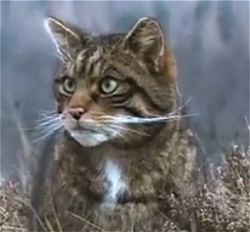Scottish wildcat

Felis Sylvestris Grampia - better known as the Scottish wildcat - is the only true wild cat in Britain. Felis Sylvestris Grampia (which is Latin for 'cat of the Grampian forests') is a larger and heavier descendant of the European wildcat (Felis sylvestris sylvestris). The British cats were isolated after the last Ice Age, approximately 7,000-9,000 years ago, as the sea level rose, making Britain an island. Once Felis sylvestris was found across the entire British mainland, but now only a handful are left, confined to the Scottish Highlands. It is estimated that less than 400 of these cats remain, making them perhaps the most endangered species in Britain.
A true wild cat, the Scottish wildcat is untameable, even if raised by humans from infancy. The species has been protected under the Wildlife & Countryside Act since 1981, but their numbers are still declining and have reached the point where some believe that the cats may be extinct within a few years. There are three main reasons why the numbers of wildcats are going down:
- loss of habitat
- direct killing by humans
- interbreeding with feral domestic cats
Causes 2 and 3 are inter-related. The bloodline of the Scottish wild cat is being bred out as declining numbers make it harder for the cats to find mates, and though the pure-bred Scottish wild cat is protected, the cross-breeds are not. Since these can be a nuisance to small livestock they may be legitimately hunted. However, there has been a change of attitude in recent years, and many farmers are now proud to boast that their lands include a wild cat range.
A Scottish wildcat looks a bit like a large, muscular tabby. The adult male is typically between 6-9kg (13-17lb) . Females are a bit smaller, weighing on average 5-7kg (11-15lb). The wild cat has a rough coat with distinctive markings which have earned it the nickname 'Tiger of the Highlands'. Another very characteristic feature of the wildcat is its thick tail with symmetrical black rings.
A scientific paper on Scottish wildcats (Kitchener et al 2005) identified seven key features which distinguish Felis Sylvestris Grampia from a domestic tabby. These are listed below:
- the wildcat shape of the stripes on the back of the neck are more wavy
- there are two stripes on the shoulders
- the tail is bushy
- the tail has a blunt, black tip
- the tail has distinct rings
- there are stripes along the lower back
- the dorsal line stops at the start of the tail.
Like most wild cats, the Scottish Wildcat is a solitary and rather elusive animal. Few people have ever seen one and even those who work within the wildcats’ habitat see them only infrequently. (A wild cat has a range of about 8km - slightly smaller for females, somewhat larger for males.) Although a wildcat is unlikely to attack a human, it may do so if it thinks it is threatened and has no way of escape. Also if a human (or any other animal) gets between a mother cat and her kittens it is likely that the cat will attack. Seven kilograms of infuriated wild cat can be dangerous, so much so that the cats were believed to be man-killers until the myth was disproven in the 1950s. The most common victims of wild cats are dogs which assume that they are chasing domestic felines, and are unpleasantly surprised when their quarry vigorously counter-attacks. (A healthy wild cat can take down an Alsatian, and smaller dogs have little chance.)
The Scottish Wildcat has no serious predators (apart from humans). It is a pure carnivore - which means it gets all its nutrition from meat -mainly from rabbits and smaller rodents. In the wild these cats live between 6-8 years. Female wildcats come into heat once a year around January or February and normally produce 3 to 4 kittens. As mentioned above, female wildcats are quite happy to mate with domestic cats and their hybrid offspring are relatively numerous in Scotland (an estimated 3500 of them). Hybrids can be identified genetically, and also generally by coat markings such as large white patches, a slimmer tail and body, or fused and broken-up stripes on the flanks.
Recently a rare wildcat has been spotted on a Scottish Island. The animal was seen and photographed by holidaymaker Peter Harris on Mull in the Inner Hebrides, about a mile from the mainland. Although it is well-known that wildcats are generally less averse to water than domestic cats and are strong swimmers, reaching the island was an epic long-distance swim. It is also unclear whether this wildcat is a pure-bred wildcat or a hybrid. A team of experts are hoping to investigate the sighting.
There's more about Scottish wildcats on this short documentary which has been split into two videos:
Part I
and Part II

